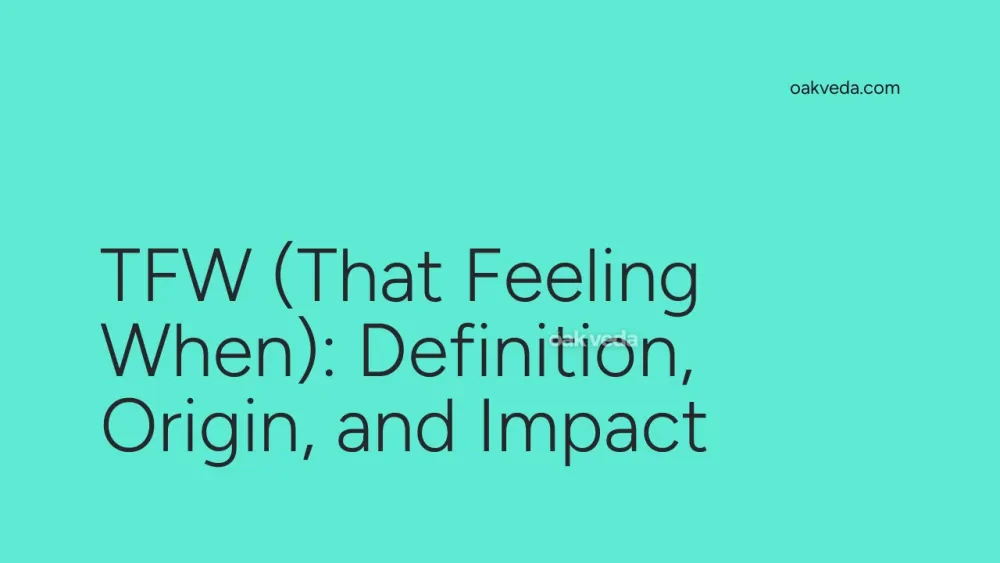
What is TFW (That Feeling When)?
TFW, an acronym for "That Feeling When," is a popular internet slang phrase used to introduce relatable situations or experiences on social media platforms. This expression serves as a preface to describe a specific emotion or scenario that the author believes will resonate with their audience. By using TFW, users can quickly establish a connection with their followers through shared experiences or emotions.
Origin and Development of TFW
The exact origin of "That Feeling When" is difficult to pinpoint, as it emerged organically from internet culture. However, its usage gained significant traction in the early 2010s on platforms like Tumblr and Twitter. The acronym "TFW" became popular as a shorthand version, allowing users to express relatable moments more concisely in character-limited posts.
As social media evolved, so did the use of TFW. It transitioned from a simple text-based expression to a key component in meme culture, often paired with images or GIFs to enhance the emotional impact of the described situation.
How TFW Works
TFW functions as a linguistic tool to create instant relatability in online communication. Here's how it typically works:
- Introduction: A post begins with "TFW" or "That feeling when..."
- Scenario description: The user describes a specific situation or emotion
- Relatability: Readers connect with the described experience
- Engagement: Users interact through likes, comments, or shares
This format allows for quick, emotional storytelling that can resonate with a wide audience, making it an effective tool for social media engagement.
Popular Examples of TFW
TFW can be applied to a vast array of situations, from mundane everyday occurrences to more specific experiences. Some popular examples include:
- "TFW you finally finish a big project"
- "That feeling when you see your favorite band live for the first time"
- "TFW you wake up thinking it's a workday but realize it's Saturday"
- "That feeling when your phone battery dies just as you need to make an important call"
These examples showcase how TFW can be used to describe both positive and negative experiences, always with the goal of creating a sense of shared understanding among users.
Impact of TFW on Social Media Culture
The widespread use of TFW has significantly impacted social media culture in several ways:
-
Enhanced Relatability: TFW has become a shorthand for creating instant connections between users by highlighting shared experiences.
-
Meme Evolution: The phrase has become a staple in meme culture, often paired with images or GIFs to create more impactful and shareable content.
-
Language Adaptation: TFW has influenced how people express themselves online, encouraging more concise and relatable communication styles.
-
Community Building: By sharing relatable moments, TFW helps foster a sense of community among social media users with similar experiences.
-
Content Creation: The format has inspired countless posts, memes, and even entire accounts dedicated to sharing relatable content.
How Brands and Influencers Use TFW
Recognizing the power of relatability, brands and influencers have incorporated TFW into their social media strategies:
-
Brand Engagement: Companies use TFW to create relatable content that resonates with their target audience, humanizing their brand and fostering customer connections.
-
Product Promotion: TFW can be used to highlight scenarios where a product or service would be particularly useful or desirable.
-
Influencer Authenticity: Influencers use TFW to share personal experiences, making their content more relatable and authentic to their followers.
-
Trend Participation: Brands and influencers can join TFW-related trends to increase visibility and engagement with their audience.
Future Trends Related to TFW
As social media continues to evolve, so does the use of expressions like TFW:
-
Visual Evolution: Expect to see more integration of TFW with visual content, including short-form videos and augmented reality filters.
-
Platform-Specific Adaptations: Different social media platforms may develop unique variations or features centered around the TFW concept.
-
AI-Generated Relatability: As AI becomes more sophisticated, we may see automated generation of TFW content tailored to individual users' experiences.
-
Cross-Cultural Expansion: The concept of TFW may adapt and spread to non-English speaking online communities, taking on new forms in different languages and cultures.
FAQs about TFW
-
Is TFW only used on social media? While primarily used on social media, TFW has also found its way into casual online communication and even some informal written contexts.
-
Can TFW be used in professional settings? Generally, TFW is considered informal and is best avoided in professional or formal communication.
-
Are there any alternatives to TFW? Yes, phrases like "MFW" (My Face When) or "When you..." serve similar functions in online communication.
-
How has TFW impacted internet language? TFW has contributed to the trend of concise, relatable expressions in online communication, influencing how people share experiences and emotions on digital platforms.
-
Is TFW still relevant in today's social media landscape? While internet trends come and go, TFW remains a popular and versatile expression, continually adapting to new platforms and content formats.
In conclusion, "That Feeling When" and its acronym TFW have become integral parts of social media culture, offering a quick and effective way to share relatable experiences. As online communication continues to evolve, TFW's influence on how we express and connect through shared moments is likely to persist, adapting to new platforms and cultural shifts in the digital landscape.
You may be interested in:
- Personal Brand: Definition, Origin, and Impact on Social Media
- Pitch in Social Media: Definition, Origin, and Impact
- Troll: Definition, Origin, and Impact on Social Media
- AMOS: Definition, Origin, and Impact on Social Media
- Drag and Drop: Definition, Origin, and Impact on Social Media
- TikTok Duet: Definition, Origin, and Impact on Social Media

